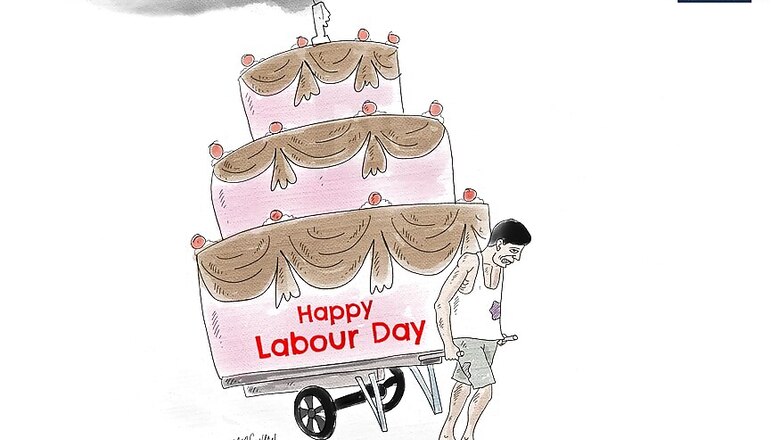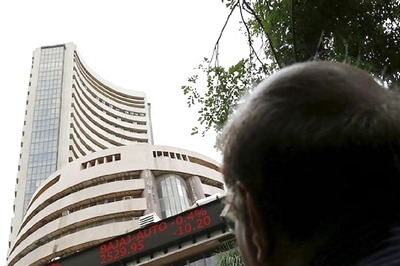
views
Government data reveal that the Indian economy is growing at a robust rate but noted economist Jean Dreze believes what really counts is not growth but the improvement of people’s living conditions. In an interview with News18’s Rupashree Nanda, Dreze, who was a member of Sonia Gandhi’s National Advisory Council and an architect of the National Employment Guarantee Act (NREGA), says that there have been no major initiatives in the social field in the last four years, with the partial exception of Swachh Bharat.The past three years have seen been back-to-back droughts followed by demonetisation. What impact do you think it has had on the rural economy? As an economist, do you see visible signs of growing distress?
The agrarian crisis, as it tends to be called, has both long-term and short-term aspects. The long-term aspects include slow growth and high uncertainty in agriculture. The agricultural sector is growing more slowly than the rest of the economy most of the time. In fact, it barely keeps up with population growth. This means that those who are unable to diversify out of agriculture tend to be left behind. Further, their livelihoods are particularly uncertain, depending as they do on good weather, remunerative prices, and other erratic factors. All this gives farmers a legitimate sense that agriculture is a losing occupation.

Much depends on what you make of official statistics. If you believe them, then the Indian economy is still growing at a trend rate about 7.5 per cent per year, with short-term fluctuations, much as it has done for the last 15 years or so. That would look pretty good to most economists. However, three qualifications are due. First, official statistics have lost some credibility in recent years. The central government has turned into a propaganda machine and it is hard to guess whether the statistical system has retained its usual independence. Even if it has, recent growth estimates are bound to be speculative as substantial parts of the informal sector went off the radar in the post-demonetisation period. Second, assuming that the official statistics are reliable, the economy seems to be losing some steam right now. According to the latest Economic Survey, the growth rate has declined for two years in a row. With the investment rate declining significantly in the last few years, the slowdown may continue. There are also other signs of poor economic health, such as the declining growth of manufacturing and the crisis of the banking system.
Third, and most importantly, what really counts is not the growth of the economy but the improvement of people’s living conditions. That is where the economic situation leaves much to be desired. One dramatic symptom of this is the virtual stagnation of real agricultural wages in the last four years. Another is the damage inflicted by demonetisation on people’s lives. The paradox, so to speak, of fast economic growth and slow social progress is far from new in India, but it is perhaps more striking than ever today.
I doubt that the government’s fixation with economic growth has much to do with any commitment to poverty reduction. More likely, it reflects superpower aspirations. If you want to improve people’s lives, economic growth would be important, but so would other enabling factors such as elementary education, social policy, gender equality, environmental protection, and so on. The NDA government is showing no interest in these matters. On the other hand, if your objective is to catch up with China, or even to reach a state where Hindus “can dictate their terms to the whole world”, as Savarkar put it in Essentials of Hindutva, then fast growth may seem like the overwhelming priority. This outlook is a good deal for people in positions of power and privilege, but it does little for human development.PM Modi had termed the NREGA as “biggest monument of UPA’s failure” but this year, Finance Minister Arun Jaitley increased the allocation for NREGA to an all-time high of Rs 48,000 crores. Do you feel this is a vindication of the NREGA?
The budget allocation for most government schemes goes up every year in terms of money if only to keep up with price increases. When that is the case, it is possible to claim every year that the allocation is at an “all-time high”, but that does not tell us much. In real terms, the NREGA budget today is still much lower than it was at its peak in 2009-10. It did increase a little in the last couple of years, but that was large to make up for the mess the NDA government had made earlier. Remember, the NREGA came under attack as soon as the new government took over in 2014, with senior politicians calling for it to be restricted to the poorest districts or even phased out. When that proved difficult, the government imposed stringent caps on NREGA expenditure, which had already stagnated in money terms in the last years of the UPA-2 government. Meanwhile, money wages were increasing because they were indexed to the price level. Employment generation was the casualty, and wage arrears also piled up. This setback is now being repaired with modest budget increases that help to restore earlier employment levels and clear the wage arrears. What these modest increases do not permit is an increase in real wages, and that is what NREGA desperately needs. If NREGA wages continue to stagnate in real terms, as they have done for many years now, the entire programme is bound to fade away sooner or later.What are the bottlenecks in the implementation of NREGA? Delay of wage payment, stagnation of real wages, lack of political will, corruption?
The biggest problem right now is that the wage payment system is in disarray. Delays in NREGA wage payments are bad enough, but now, under the Aadhaar-based payment system, workers also face a severe problem of failed payments. According to the NREGA’s management and information system, nearly Rs 500 crore of wage payments were rejected in the last financial year. Sometimes payments are rejected because of data entry errors or inconsistencies between the Aadhaar, NREGA and bank databases. Sometimes wages are credited to Jan Dhan accounts people have never heard of because they were opened without their consent. Sometimes the money goes into someone else’s account, or to an Airtel wallet. Sometimes wage payments are rejected because a worker’s account has been closed, without his or her knowledge, for lack of e-KYC or other technical reasons. Sometimes the payment system returns an error message that no-one seems to understand. Sometimes wages have been credited but workers are told that their account has been “frozen” for any number of obscure reasons. And of course, no assistance is available to NREGA workers as they run from pillar to post for their meagre wages. The entire payment process has become a nightmare. Aside from causing enormous hardship to NREGA workers, this opens the door to corruption. When honest workers lose interest in NREGA, corrupt middlemen have a field day. I am not sure about other states, but in Jharkhand at least the programme is at risk of going to the dogs unless the payment system is streamlined.My experience has shown that NREGA has not been successful in stemming distress migration – whether we talk of Bolangir or Bundelkhand? Why is that?
Recent research shows that, in the past, NREGA did reduce distress migration in areas where it was reasonably well implemented, such as southern Rajasthan. If that is not the case in Bolangir or Bundelkhand today, it must partly because NREGA wages are too low and partly because employment is hard to get. The whole idea of NREGA was that employment would be available on demand at the minimum wage. That happened to some extent in the early years, when people were allowed to turn up at the worksites without formalities. Today, however, all sorts of technicalities have undermined the principle of work on demand. NREGA wages are also lagging behind minimum wages and even market wages. For good measure, wage payments are often delayed if not rejected. In this situation, it is not surprising that many people decide to migrate during the slack season rather than depend on uncertain and unrewarding work opportunities under NREGA.The Modi government has promised to double farmers’ incomes by 2022. Is that doable?
This is an empty promise. We have no reliable data on farmers’ incomes, so promising to double them does not commit the government to anything. Doubling farmers’ incomes by 2022 would require a growth rate of 20 per cent per year in real terms for four years in a row. I am not aware that this sort of runaway growth has ever been achieved anywhere in the world. Nor am I aware of any measure the government has taken that might produce such a miracle. It is frustrating to see the mainstream media lapping up so many of the government’s bloated promises and discussing them as if they were serious proposals. Another example is Modicare, successfully projected as “the world’s largest health care programme” despite its microscopic budget.You have been one of the biggest critics of Aadhaar and have fought against it being linked to PDS, pensions, etc. What has been your experience of Aadhaar on the ground?
My experience is largely based on Jharkhand, where Aadhaar has caused havoc. The linking of Aadhaar to welfare schemes was necessarily coercive since people have no stake in it. To enforce it, deadlines were set and those who were not able to link in good time were excluded after that. You don’t do that to the privileged classes, that’s why the deadlines for linking of phones and bank accounts keep getting extended. But poor people have no power, so they get shock treatment. We know for a fact that ration cards, NREGA job cards and even pensions have been cancelled en masse in Jharkhand for the sake of achieving 100% Aadhaar seeding. For good measure, the government claimed in each case that Aadhaar had enabled it to save money. It did, but at what cost to poor people? All this, however, is just a trailer. The real torture starts when Aadhaar-based biometric authentication (ABBA) is imposed. It is a mystery how the wizards of Aadhaar thought that ABBA would work in rural Jharkhand, where connectivity failures are rampant. So far, ABBA has been imposed mainly on the public distribution system, with sobering results. There are a sensible and well-tested alternative such as smart cards, already used with good effect in states like Tamil Nadu and Himachal Pradesh. Nevertheless, the drive for wider use of ABBA continues, because Aadhaar is a kind of fetish for the central government.The NDA government has claimed to be pro-poor. How do you see that claim against its allocation for social welfare programmes?
Every government claims to be pro-poor. Looking at the facts, the goals of social policy under the Modi government can be summed up in two words: save money. That explains why NREGA wages are frozen in real terms, why maternity benefits are still being denied in violation of the National Food Security Act, and why the central contribution to social security pensions continues to stagnate at a measly Rs 200 per month. The last example is particularly striking as 60 eminent economists had written to the Finance Minister last December to recommend a modest increase in pensions.
The message is clear: the poor should help themselves. Even budget allocations for child nutrition schemes such as midday meals and ICDS were slashed by a staggering 36% and 50% respectively, in the Modi government’s first Union Budget, though this was partly reversed later under public pressure. Against this demolition job, there have been no major initiatives in the social field in the last four years, with the partial exception of Swacch Bharat if you overlook its authoritarian aspects. The schooling system continues to languish, condemning millions of children to a life of hard labour for lack of elementary education. As far as health is concerned, the central government managed to get away with empty promises year after year and do virtually nothing. In social policy as in many other fields, rhetoric and reality are on different planets today.


















Comments
0 comment